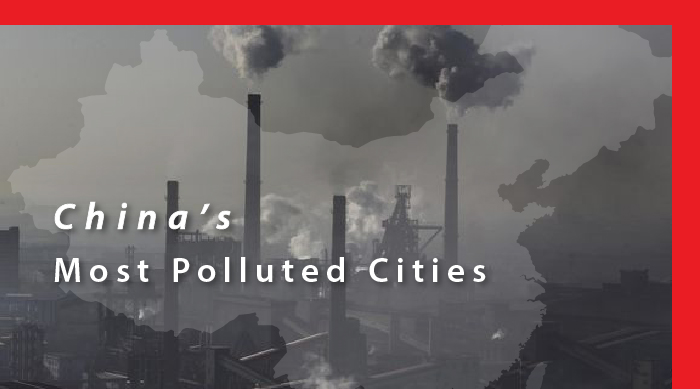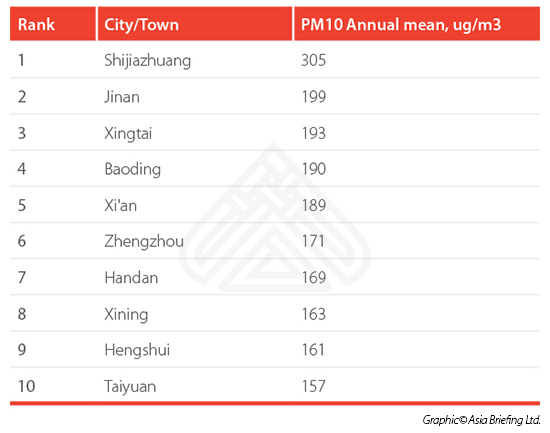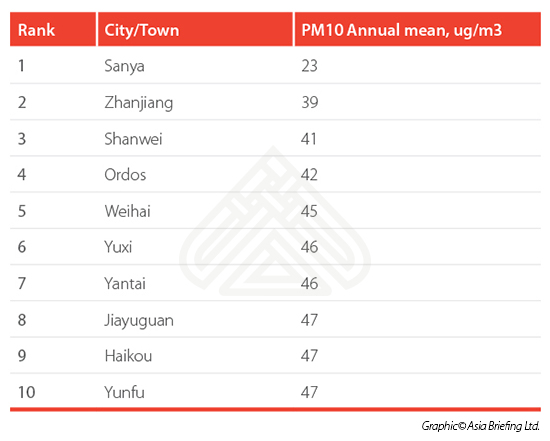China’s Most Polluted Cities – What it Means for Business
By Gidon Gautel
Five of China’s ten most polluted cities are located in Hebei province in the country’s north, with the city of Shijiazhuang ranking the highest, according to the latest data from the World Health Organization’s (WHO) Ambient Air Pollution Database.
WHO information shows that air pollution in certain areas of China has markedly improved since 2011. Beijing, which was ranked the fifth most polluted city in China in 2011, has dropped out of the top 20. This is partially due to increasing efforts by the government to address air quality issues, though it still ranks 12th for levels of PM2.5.
The drive to tackle China’s air pollution presents a variety of opportunities for foreign investors. Foreign businesses in green industries will benefit from easier market entry and greater demand for cleantech products, while firms in highly polluted cities will enjoy higher retention rates for employees as a result of cleaner air. However, significant challenges remain as China continues to pollute heavily and numerous obstacles will have to be overcome to successfully curb air pollution.
WHO’s list of most and least polluted cities in China
Updated in May 2016, the WHO’s database focuses on levels of particulate matter smaller than 10 micrometers (PM10) and 2.5 micrometers (PM2.5). Both can cause serious respiratory diseases including lung cancer, especially PM2.5, which penetrate deeper into lung tissue.
A 2013 joint study by Tsinghua University, Peking University, and the Massachusetts Institute of Technology (MIT) revealed that high levels of air pollution in northwest China reduced life expectancy by 5.5 years, on average.
The top 10 most polluted Chinese cities, in terms of air pollution, are ranked as follows:
China’s least polluted cities tend to be situated in the south, with Sanya topping both the PM10 and PM2.5 tables for lowest pollution levels. Hong Kong, not included in the original 2011 WHO China data, has seen a slight drop of air quality since then, from PM10 levels of 47mcg/m3 to 49, taking it out of the top 10 cleanest list.
The top 10 least polluted Chinese cities, in terms of air quality, are as follows:
The full report, covering all major cities across the globe, can be found here.
![]() RELATED: Investing in China’s Green Industries
RELATED: Investing in China’s Green Industries
The government’s strained efforts to crack down on polluters
The country’s capital, Beijing, has drawn international criticism for its highly-publicized levels of pollution, which may explain why the government has been aggressively targeting the problem there and in the general Beijing-Tianjin-Hebei (Jing-Jin-Ji) area. The Ministry of Environmental Protection announced in March this year that PM2.5 and PM10 concentrations in the region still needed to be cut by 60 percent and 50 percent, respectively, in order to meet national standards.
The government has introduced punitive fines and revised tax laws to try to lower pollution levels across major cities. Despite this, from 2011’s 20 worst polluted cities, only Beijing has seen improvements thus far. Nationally, general levels of pollution have worsened. PM10 levels recorded in 2016 for Shijiazhuang were twice as high as PM10 levels recorded in 2011 for Lanzhou, the most polluted city in China that year.
Shijiazhuang’s annual mean concentration of PM10 was 305 micrograms per cubic meter (mcg/m3), more than 15 times higher than the WHO’s recommended annual upper limit of 20 mcg/m3. Shijiazhuang’s annual mean concentration of PM2.5 was 121 mcg/m3, more than 12 times higher than the WHO’s recommended annual limit of 10 mcg/m3.
There is some concern over the accuracy of this data as the WHO uses official Chinese sources, which have a reputation of being imprecise and distorted. For example, seven local officials in Xi’an were jailed this month for tampering with data and stuffing cotton gauze into sensors to create more favorable readings.
To its credit, the central government has acknowledged the problem and introduced measures of control over local authorities. On June 19, Premier Li Keqiang signed new legislation on statistical data which detailed harsher punishments for falsifying or tampering with the information. Despite this, concerns over data accuracy, particularly in regards to the environment, remain.
In addition, even though the legislation may be signed, that does not mean that it is effectively implemented. Noncompliance remains a critical issue. Of the 4,077 firms recently inspected by the monitoring department of the Ministry of Environmental Protection in the Beijing-Tianjin-Hebei area, 70 percent broke environmental laws.
![]() RELATED: Pre-Investment and Entry Strategy Advisory from Dezan Shira & Associates
RELATED: Pre-Investment and Entry Strategy Advisory from Dezan Shira & Associates
Opportunities for foreign businesses
The government’s campaign to combat air pollution presents an array of opportunities and benefits for foreign investors and businesses operating in China.
For those looking to invest in Chinese A Shares, China’s cleantech firms are the fastest growing in APAC, and make up 36 percent of the Clean200 list (a compilation of the largest green energy and technology firms in the world), with a combined clean energy revenue of US$35 billion.
VC/PE investment into smaller firms also looks promising, as the total disclosed investment value in Q1 of 2016 into the cleantech/renewables industry totaled US$657 million. Opportunities for early stage investments into cleantech startups may also grow, as Chinese innovators look for creative solutions to national air problems.
Poor air quality has also opened a large market for monitoring equipment and air purifiers. Sales for monitoring and abatement equipment will be driven by private companies looking to find sources of their pollution, rather than traditional public sector clients trying to monitor air quality.
The air purifier market is largely fueled by demand from homes and small businesses, and has seen 70 percent year-on-year growth since 2015.
Cleaner air in cities like Beijing may also improve employee retention rates, as foreign businesses list poor air quality as the number one issue affecting their ability to attract and retain talent.
Finally, foreign green businesses may enjoy financial and regulatory incentives. Regulatory fast tracking is a possibility, and the Ministry of Commerce’s newly updated Catalogue for the Guidance of Foreign Investment Industries is rife with “environmentally-friendly” industries encouraged for foreign investment. Tax incentives and government grants are available, such as those in Boston Power’s 2011 US$125 million battery manufacturing deal with GSR Ventures. Green technology developers would also do well to look towards China for strategic and joint development options, like EcoMotors’ 2014 signing of a US$200 million licensing agreement with Zhongding Power to share use of its highly efficient OPOC engines.
Opportunities for foreigners in China will endure, and new ones will continually present themselves, as the government persists in dealing with air pollution and continues to view aligning China as a global leader in environmental protection as an ever-increasing priority.
Editor’s note: This article was originally published on September 28, 2011, and has been updated to include the latest statistics and developments.
|
China Briefing is published by Asia Briefing, a subsidiary of Dezan Shira & Associates. We produce material for foreign investors throughout Asia, including ASEAN, India, Indonesia, Russia, the Silk Road, and Vietnam. For editorial matters please contact us here, and for a complimentary subscription to our products, please click here. Dezan Shira & Associates is a full service practice in China, providing business intelligence, due diligence, legal, tax, IT, HR, payroll, and advisory services throughout the China and Asian region. For assistance with China business issues or investments into China, please contact us at china@dezshira.com or visit us at www.dezshira.com
|

Dezan Shira & Associates Brochure
Dezan Shira & Associates is a pan-Asia, multi-disciplinary professional services firm, providing legal, tax and operational advisory to international corporate investors. Operational throughout China, ASEAN and India, our mission is to guide foreign companies through Asia’s complex regulatory environment and assist them with all aspects of establishing, maintaining and growing their business operations in the region. This brochure provides an overview of the services and expertise Dezan Shira & Associates can provide.
An Introduction to Doing Business in China 2017
This Dezan Shira & Associates 2017 China guide provides a comprehensive background and details of all aspects of setting up and operating an American business in China, including due diligence and compliance issues, IP protection, corporate establishment options, calculating tax liabilities, as well as discussing on-going operational issues such as managing bookkeeping, accounts, banking, HR, Payroll, annual license renewals, audit, FCPA compliance and consolidation with US standards and Head Office reporting.
Payroll Processing in China: Challenges and Solutions
In this issue of China Briefing magazine, we lay out the challenges presented by China’s payroll landscape, including its peculiar Dang An and Hu Kou systems. We then explore how companies of all sizes are leveraging IT-enabled solutions to meet their HR and payroll needs, and why outsourcing payroll is the answer for certain company structures. Finally, we consider the potential for China to emerge as Asia’s premier payroll processing center.
- Previous Article Labor Disputes in China: Prepare for Aggressive Negotiating, Uncomfortable Concessions – Part Two
- Next Article Tax Considerations for Legal Representative Offices in China















